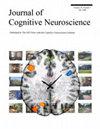声乐情感感知中 "什么 "比 "哪里 "更快?
IF 3.1
3区 医学
Q2 NEUROSCIENCES
引用次数: 0
摘要
声音携带着大量关于说话者的信息(如情绪状态、空间位置等)。神经成像研究推测,空间("在哪里")和情感("是什么")线索由部分独立的处理流进行处理。尽管行为学证据揭示了情绪与空间之间的相互作用,但这些过程在大脑中的时间动态及其受注意力的调节仍是未知数。我们研究了在语音处理过程中,空间和情感特征是否以及如何随着注意力的集中而相互作用。不同情绪(中性、愉悦、愤怒)的空间化非语言发声出现在头部周围的不同位置,而听者会辨别声音的空间位置或情绪质量。神经活动通过脑电图的 ERPs 进行测量。在脑电图会话结束时收集情感评分。情绪化的发声引起 N1 下降,但 P2 和晚期正电位振幅上升。空间和情绪的交互作用发生在显著性检测阶段:在右侧(与左侧)位置出现的中性发声会引起 P2 振幅的增加,但情绪发声则没有这种差异。当任务指令涉及情绪分类时,在前方(与后方)位置出现的发声会增加 P2。在行为上,只有情绪和唤醒评级显示出情绪空间的交互作用。这些发现表明,在语音处理过程中,情感表征比空间表征更早被激活。情绪线索的知觉优先级与任务指示无关,但与空间刺激表征的增强并不同步。这些发现支持了听觉处理通路对情感信息的不同反应。本文章由计算机程序翻译,如有差异,请以英文原文为准。
What Is Faster than Where in Vocal Emotional Perception
Voices carry a vast amount of information about speakers (e.g., emotional state; spatial location). Neuroimaging studies postulate that spatial (“where”) and emotional (“what”) cues are processed by partially independent processing streams. Although behavioral evidence reveals interactions between emotion and space, the temporal dynamics of these processes in the brain and its modulation by attention remain unknown. We investigated whether and how spatial and emotional features interact during voice processing as a function of attention focus. Spatialized nonverbal vocalizations differing in valence (neutral, amusement, anger) were presented at different locations around the head, whereas listeners discriminated either the spatial location or emotional quality of the voice. Neural activity was measured with ERPs of the EEG. Affective ratings were collected at the end of the EEG session. Emotional vocalizations elicited decreased N1 but increased P2 and late positive potential amplitudes. Interactions of space and emotion occurred at the salience detection stage: neutral vocalizations presented at right (vs. left) locations elicited increased P2 amplitudes, but no such differences were observed for emotional vocalizations. When task instructions involved emotion categorization, the P2 was increased for vocalizations presented at front (vs. back) locations. Behaviorally, only valence and arousal ratings showed emotion–space interactions. These findings suggest that emotional representations are activated earlier than spatial representations in voice processing. The perceptual prioritization of emotional cues occurred irrespective of task instructions but was not paralleled by an augmented stimulus representation in space. These findings support the differential responding to emotional information by auditory processing pathways.
求助全文
通过发布文献求助,成功后即可免费获取论文全文。
去求助
来源期刊
CiteScore
5.30
自引率
3.10%
发文量
151
审稿时长
3-8 weeks
期刊介绍:
Journal of Cognitive Neuroscience investigates brain–behavior interaction and promotes lively interchange among the mind sciences.

 求助内容:
求助内容: 应助结果提醒方式:
应助结果提醒方式:


